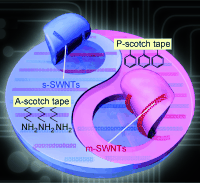A combined Finnish, Russian, and Danish team have found a way to control the chirality of single-walled carbon nanotubes according to an Apr. 30, 2013 news item on Azonano,
An ultimate goal in the field of carbon nanotube research is to synthesise single-walled carbon nanotubes (SWNTs) with controlled chiralities. Twenty years after the discovery of SWNTs, scientists from Aalto University in Finland, A.M. Prokhorov General Physics Institute RAS in Russia and the Center for Electron Nanoscopy of Technical University of Denmark (DTU) have managed to control chirality in carbon nanotubes during their chemical vapor deposition synthesis.
The Aalto University Apr. 29, 2013 news release, which originated the news item, goes on to explain,
Over the years, substantial progress has been made to develop various structure-controlled synthesis methods. However, precise control over the chiral structure of SWNTs has been largely hindered by a lack of practical means to direct the formation of the metal nanoparticle catalysts and their catalytic dynamics during tube growth.
– We achieved an epitaxial formation of Co nanoparticles by reducing a well-developed solid solution in CO, reveals Maoshuai He, a postdoctoral researcher at Aalto University School of Chemical Technology.
– For the first time, the new catalyst was employed for selective growth of SWNTs, adds senior staff scientist Hua Jiang from Aalto University School of Science.
By introducing the new catalysts into a conventional CVD reactor, the research team demonstrated preferential growth of semiconducting SWNTs (~90%) with an exceptionally high population of (6,5) tubes (53%) at 500 °C. Furthermore, they also showed a shift of the chiral preference from (6,5) tubes at 500 °C to (7, 6) and (9, 4) nanotubes at 400 °C.
– These findings open new perspectives both for structural control of SWNTs and for elucidating their growth mechanisms, thus are important for the fundamental understanding of science behind nanotube growth, comments Professor Juha Lehtonen from Aalto University.
For anyone like me who needs a description of chirality, there’s this from Wikipedia,
Chirality (pron.: /kaɪˈrælɪtiː/) is a property of asymmetry important in several branches of science. The word chirality is derived from the Greek, χειρ (kheir), “hand”, a familiar chiral object.
An object or a system is chiral if it is not identical to its mirror image, that is, it cannot be superposed onto it. A chiral object and its mirror image are called enantiomorphs (Greek opposite forms) or, when referring to molecules, enantiomers. A non-chiral object is called achiral (sometimes also amphichiral) and can be superposed on its mirror image.
…
Human hands are perhaps the most universally recognized example of chirality: The left hand is a non-superimposable mirror image of the right hand; no matter how the two hands are oriented, it is impossible for all the major features of both hands to coincide.[2] This difference in symmetry becomes obvious if someone attempts to shake the right hand of a person using his left hand, or if a left-handed glove is placed on a right hand. In mathematics chirality is the property of a figure that is not identical to its mirror image.
One of the researchers notes why they, or anyone else, would want to control the chirality of carbon nanotubes, from the news release,
– Chirality defines the optical and electronic properties of carbon nanotubes, so controlling it is a key to exploiting their practical applications, says Professor Esko I. Kauppinen, the leader of the Nanomaterials Group in Aalto University School of Science.
ETA Apr. 30, 2013 at 4:20 pm PDT: Here’s a link to and a citation for the team’s published paper,
Chiral-Selective Growth of Single-Walled Carbon Nanotubes on Lattice-Mismatched Epitaxial Cobalt Nanoparticles by Maoshuai He, Hua Jiang, Bilu Liu, Pavel V. Fedotov, Alexander I. Chernov, Elena D. Obraztsova, Filippo Cavalca, Jakob B. Wagner, Thomas W. Hansen, Ilya V. Anoshkin, Ekaterina A. Obraztsova, Alexey V. Belkin, Emma Sairanen, Albert G. Nasibulin, Juha Lehtonen, & Esko I. Kauppinen. Scientific Reports 3, Article number 1460 doi:10.1038/srep01460 Published15 March 2013
This article is open access.
